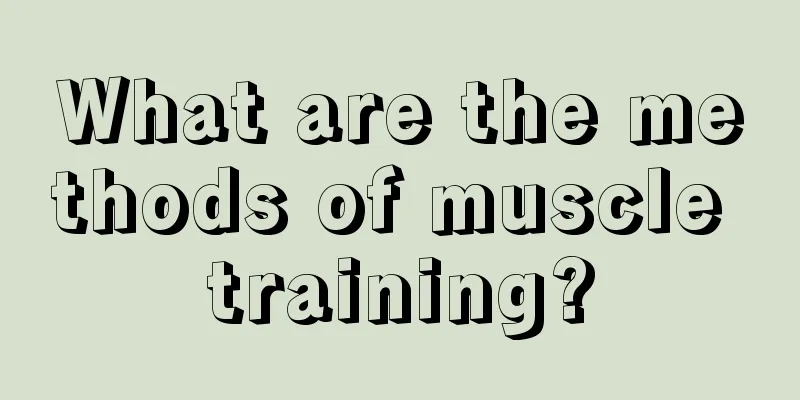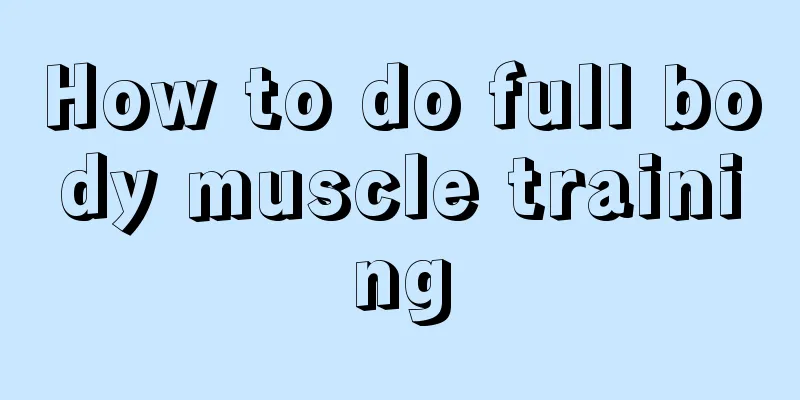What are the methods of muscle training?

|
There are many ways to exercise muscles, but now more and more people like to exercise muscles with their bare hands. This is certainly not a joke. Even if you don’t have barbells, dumbbells and other equipment on hand, but still want to exercise muscles, it can be done. How to do it? Today let us introduce to you in detail several methods of exercising muscles with bare hands. Friends who want to exercise muscles but don’t have any equipment can follow our steps below to learn together. The muscle development method is a dynamic exercise, that is, during exercise, muscle contraction and relaxation are performed alternately, and the limbs are displaced in space. The characteristic of static exercise is that the muscles are tense and exert force, but the limbs remain still. Static exercises can mobilize more muscle fibers to exert tension and are therefore more effective in increasing absolute strength. Before doing static exercises, it is generally necessary to take a deep breath and then exhale slowly during the exercise. The following is a static exercise method that does not require any equipment. 1. Neck (1) Stand with your feet naturally apart, cross your fingers and hold them behind your head. Use steady force to push your head forward and downward, while using your neck to provide appropriate resistance to prevent your hands from pushing your head down. Maintain this "frozen" position for 8 to 10 seconds or slightly longer, then relax. When practicing, you should straighten your chest and stomach, and avoid hunching your back. (2) Place your right hand on the right side of your head and push your head down to the left, while using your neck to provide appropriate resistance to prevent your hand from pushing your head down to the left. Maintain this "frozen" position for 8 to 10 seconds or slightly longer, then relax. Then change direction and practice. When practicing, the upper body should be kept upright and not lean to one side. 2. Chest (1) Push-ups are a dynamic exercise. Here we introduce a static push-up. When doing push-ups, when the body descends to the point where the chest is about to touch the ground, the pectoralis major muscles are extremely tense. Maintain this static position for 8 to 10 seconds or slightly longer, then relax. (2) Stand facing a wall with your arms raised in front of you, until your fingertips are just about to touch the wall but not quite. Stand straight, lean forward, and place your palms against the wall with your fingertips facing upward. Bend your elbows, with your upper arms and forearms at a 90-degree angle, and move your upper body closer to the wall. Keep your arms bent at the elbows to support your upper body, without letting your body lean against the wall. Keep your pectoralis major muscles extremely tense. Maintain this static position for 8 to 10 seconds or slightly longer, then relax. 3. Shoulders Open the door and stand in the door frame with your arms hanging down and your fists loosely clenched, with the backs of your hands facing forward. Then spread your arms to the sides and press your fists against the door frame as if you want to prop it open. Keep your deltoid muscles extremely tense. Maintain this static position for 8 to 10 seconds or slightly longer, and then relax. 4. Back Stand or sit, put your hands on your hips, tighten your latissimus dorsi muscles and open them to both sides. Maintain this static position for 8 to 10 seconds or a little longer, then relax. 5. Arm (1) Sit at a desk, hold the bottom edge of the desk with both hands, with your upper arm and forearm at a 90-degree angle, as if trying to lift the desk. Keep your biceps extremely tense, maintain this static position for 8 to 10 seconds or a little longer, and then relax. (2) Stand upright with your arms hanging naturally at your sides, and your hands loosely clenched into fists with the backs of your hands facing backwards. Raise both arms straight up and backward, with the upper body slightly leaning forward. Raise both arms until you can't lift them any further. Keep the triceps extremely tense. Maintain this static position for 8 to 10 seconds or slightly longer, then relax. (3) Stand or sit with your arms hanging down and your hands clenched into fists with the backs of your hands facing backwards. Bend your wrist as far as you can, tense your forearm muscles extremely, and maintain this static position for 8 to 10 seconds or slightly longer. Then relax. 6. Abdomen (1) Lie on your back with your ankles fixed and your upper body sitting up. The angle between your upper body and lower limbs should be greater than 90 degrees. Your rectus abdominis should be extremely tense. Maintain this static position for 8 to 10 seconds or slightly longer, then relax. (2) Lie on your back with your lower limbs and upper body raised into a "V" shape. Keep your rectus abdominis extremely tight. Maintain this static position for 8 to 10 seconds or slightly longer, then relax. 7. Legs (1) Half squat, keep your thighs horizontal, and your upper body as vertical as possible to the ground. Cross your arms in front of your chest and tighten your quadriceps. Hold this position for 8 to 10 seconds or a little longer, then relax. (2) Sit with your toes touching the ground, your heels lifted as far as possible, and your calf triceps stretched to the utmost. Hold this position for 8 to 10 seconds or slightly longer, then relax. Conclusion: The characteristic of static exercise is that the muscles are tensed and exerted, but the limbs are still. Many people get bored after a long time, and the passion of traditional muscle and equipment collision is nowhere to be found. However, to achieve this effect, you just have to be content to be punished to "do it statically". The above is our detailed introduction to the method of bare-handed muscle training. I believe that many people think this is impossible, but now there is indeed a method of energetic training, which can make more muscle fibers tense and exert force for exercisers, so it is also better for enhancing absolute strength. So, friends, hurry up and try it! |
<<: How to train arm muscles with dumbbells
>>: What are the ways to build muscle
Recommend
4 tips to teach you how to keep running
Long-term running is very beneficial to the healt...
Is it better to run in the morning or in the evening?
If you want to have a healthy body, you must pay ...
How to choose fitness equipment
Nowadays, many people have learned various ways o...
How long should you stretch after a run?
After running, many people will go home directly ...
How to stretch after exercise
Stretching exercises after exercise can help us r...
What are some aerobic breathing exercises?
Aerobic exercise is usually mentioned in contrast...
What kind of dance is good for middle-aged people to learn?
When people talk about dance, young and graceful ...
What are outdoor sports?
There are many outdoor enthusiasts who go to some...
What should you pay attention to when swimming?
Generally, when the weather is hot in summer, peo...
What are the benefits of couples yoga?
Many people like to practice yoga. Now a couple y...
What are some ways to exercise your neck muscles?
In some film and television promotional materials...
What are the ways to build muscle for men?
There are many ways for men to build muscle, and ...
What are the key points of double-foot jumping in badminton?
Badminton is a popular leisure sports activity. M...
How to build muscle
Muscle training is something that many male frien...
How exercise can lower blood lipids
We all know that once people get older, their bod...









